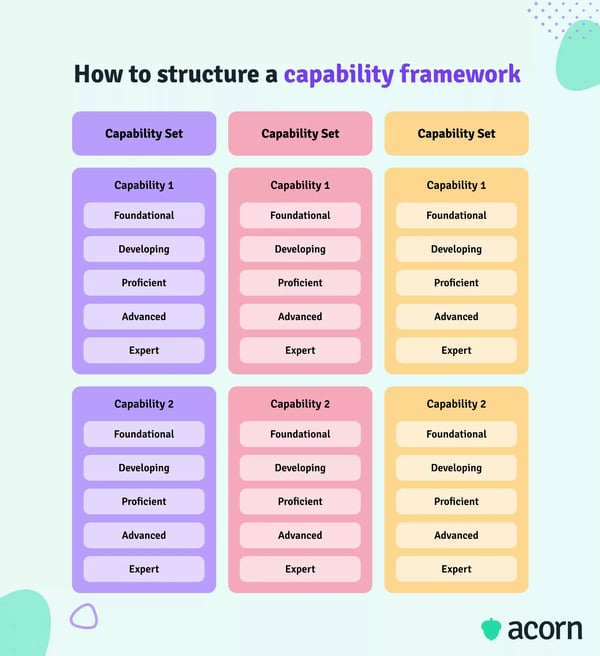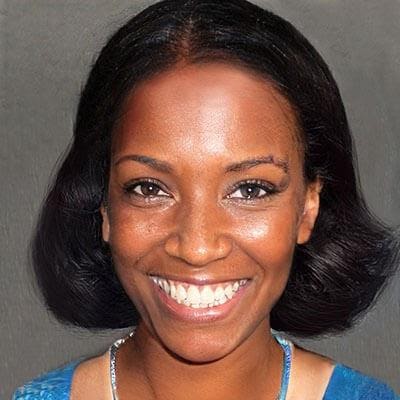October 10, 2025
 by Blake Proberts / October 10, 2025
by Blake Proberts / October 10, 2025

Workforce planning and development is a hot topic in every organization. However, many still struggle to launch effective change programs.
Too often, HR initiatives like performance management, learning management, and even talent management don’t impact organizational growth or objectives as they should.
Fortunately, there is another way: the capability framework.
A capability framework defines the core skills, behaviors, and knowledge required to perform effectively in a specific role or across an organization. It aligns workforce development with strategic goals by outlining clear expectations, promoting consistency in performance, and guiding training and career progression.
A capability framework integrates with HR processes to strengthen business performance. It provides a holistic overview of organizational and human capabilities and their assigned competencies. The framework enhances HR processes to be truly strategic by aligning HR management activities with organizational goals.
Let’s dive into the essentials of structuring and building a capability framework and how they connect learning and performance to enhance business growth.
A capability framework is made up of five key components that are crucial for its effectiveness. Without these components, it becomes less of an actionable tool and more of a vague L&D concept.
Now that we’ve explored the different components of a capability framework, it’s important to distinguish between the types of capabilities organizations focus on.
A capability framework distinguishes between two key types of capabilities: business and human. Both are essential, but they operate at different levels of the organization.
Both types of capabilities are interdependent. Strong human capabilities help build strong business capabilities, and together they align people development with organizational strategy.
No learning and development (L&D) program is truly strategic unless it’s consistent across the organization. A capability framework makes that possible by giving everyone a shared language for skills, behaviors, and performance expectations.
When applied across teams, it ensures everyone is aligned on what good looks lik, whether in hiring, training, or performance management. This alignment helps leaders make smarter decisions about where to invest in people and which capabilities matter most to business goals.
A capability framework enables:
Instead of one-off training programs, HR teams can use capability frameworks to build a more intentional and measurable development plan. It becomes easier to:

Source: Acorn
If your team struggles with inconsistent performance expectations, unclear career paths, or hard-to-identify skill gaps, it may be time for a capability framework. It helps align people development with business goals, making hiring, learning, and performance more strategic and measurable.
Capability framewowk is a tool that connects talent, learning, and performance. Here’s how HR teams can apply it across key people processes.
We often think of a capability framework as something that only benefits the business as it currently stands, from enabling L&D opportunities to identifying individuals for succession planning. However, given that a capability framework covers all the capabilities required of specific roles, it supports all aspects of talent management, both internal and external.
Capability frameworks outline the capability requirements for each position within the business. This helps in two ways:
Using a capability development framework for L&D is essential. LinkedIn once found that 94% of employees would stay with companies longer if employers invested in their professional development. A more recent report shows that 53% of Gen Z workers (the next big workforce demographic) value learning for career progress more than any other generation in the workforce.
Capability frameworks let you assess how well employees perform the required capabilities. Where there are capability gaps, there are development opportunities and development plans to be made. Organizations can use capability frameworks to target learning and development at specific capability gaps to provide more meaningful learning.
In other words, learning needs to be relevant to an individual’s needs and goals. It’s the only way to facilitate improvement in employee and business performance.
Traditionally, performance management has been a once-a-year event in which managers break down employees’ good and bad performance over the year. A lot of times, those breakdowns and insights don’t lead to tangible action plans for employees to take.
A capability framework changes that by providing a clear map of capability requirements across the organization. It provides a clear guide for how employees should be performing if they aren’t currently meeting those requirements.
In other words, a capability framework bridges the gap between performance reviews and actionable steps for employee improvement. It creates a foundation for more objective performance assessments, development needs, and career pathways.
Knowing how to structure a capability framework is crucial to ensure it’s actually usable by your business. If it’s not done right, it can become a disorganized set of capabilities that aren’t linked to anything.
To avoid this, capability frameworks are broken down into three categories:
These categories first establish capabilities at the business level, and then groups of smaller capabilities are established that feed into them. These capabilities are defined in business terms, so if the capability can’t be defined in terms of its importance to overall business priorities, then it’s not actually a capability.
Now, before we go deeper, its important to know the difference between capabilities and competencies.
Some places will tell you that capabilities and competencies are the same thing, but that just isn’t true. Capabilities have competencies, while competencies are measurements of capability.
Let’s break that down.
The key takeaway:
Recognizing this distinction helps HR and L&D teams design development programs that not only build new capabilities but also strengthen competency levels across the organization.
“Capabilities and competencies have grown in importance in performance management over the past few years. With the growing skills gap, ensuring that new abilities directly translate into better performance is more of a priority for a company's bottom line.”
Grace Savides
Senior Research Analyst, G2
It can be easy here to fall into the trap of grouping capabilities in a hierarchy, whether that’s a hierarchy of importance or a hierarchy of job roles. A capability framework should group capabilities according to category first and hierarchy second and should have a balance of technical and soft skills across the framework.

Source: Acorn
Core or organizational capabilities are the highest category of capability in a framework. They’re the overarching business capabilities that outline the actions needed to meet strategic objectives.
To define organizational capabilities, ask yourself: How does the business perform core functions to generate business value?
Capabilities at this level use fairly generic language because they need to apply broadly to the business. Core capabilities include strategic delivery, communication, and resilience. They’re pretty broadly defined because it’s the sub-capabilities that fall under each of them that give more context.
Sub-capabilities are core capabilities broken down into specific skills, knowledge, behavior, processes, and tools. They’re a collection of capabilities that fall under broader core capability categories to add deeper context. Under the core capability communications you might have “managing and creating corporate identity” as a sub-capability.
It’s important not to go overboard here. Too many sub-capabilities can become a nightmare to develop (to say nothing of tracking that development). Enterprises tend to have around 10-20 sub-capabilities, which can be organized into core capabilities like business departments or functions such as marketing or sales.
There shouldn’t be any capabilities duplicated across different departments, either. Duplication just means you lack internal communication, resulting in the development of the same capability twice. That’s a lot of wasted time and effort.
Another issue is that siloed information can’t be effectively integrated with each other to make meaningful insights about capability performance.
For example, suppose department A and department B are developing the same capability at the same time but tracking progress separately. It will become difficult to consolidate separate data sets on the progress of capability development. That means you end up with version control issues and a lack of accurate, up-to-date data.
The best way to organize sub-capabilities into departments and hierarchies is to make a business capability map outlining where all your capabilities lie within the organization.
A business capability map is a centralized source of truth across the whole organization based on big-picture priorities. It’s a visual asset that all stakeholders, including internal teams, can see and understand where capabilities fall in relation to each other. It’s also a great way to ensure teams see where they’re contributing strategic value to the business because it’s more likely to make them engage with change programs.
Competencies are the levels of proficiency used to measure capabilities. These form the basis of employee performance evaluations.
The ideal number of competencies per capability is three, but some capabilities may go up to five. At the very least, your range of competencies should cover the following levels of performance:
Ideally, you want all your employees to be advanced in their capabilities. This ensures that as businesses evolve and adapt to market changes over time, the workforce is well-equipped to adapt and perform as well.
The capabilities that are most important to develop will change based on industry changes, emerging technologies and standards, and business goals. Organizations can use a business capability heat map alongside their capability framework to identify and prioritize capabilities for development.
The most effective capability frameworks are tailored to your business needs. After all, core capabilities, job roles, departments, and even the use case of a capability framework vary from business to business.
The first step is to decide on the goals and scope of your project. A capability framework provides a foundation for multiple business activities, like performance, learning, and talent management.
However, there’s no point in building an in-depth capability framework if you don’t intend to use it business-wide. Thus, make sure your capability framework goals are aligned with your organization’s broader objectives. This will allow you to use it across the organization and maintain uniformity.
You could ask yourself: What outcomes do you want to use the framework to achieve? Is it to improve workforce planning, employee development, or performance management? This ties your capability framework to measurable business outcomes, which makes reviewing and updating the framework later on much easier.
You need to gather data on the business so that the framework presents an objective overview of the business and its functions. Make sure you engage and get buy-in from relevant stakeholders, such as managers and leaders.
Many change programs usually fail because of resistance to change or a lack of leadership support. You have to convince business leaders by showing them how a capability framework will address their pain points. If their main concern is driving more revenue for the business, then show them how the framework addresses capabilities that will increase revenue.
Beyond leadership, you will also need to align with business unit leaders, who will have their own KPIs and pain points. After all, a capability framework can’t effectively further the organization’s goals if it’s alienating business functions. These leaders will have insights into the development needs of their specific departments, which you can use to build out sub-capabilities in the framework.
Now that you have detailed job descriptions and responsibilities recorded, you can use them to define and assign relevant capabilities. You could do this manually, but using a tool to do the heavy lifting for you is easier. A learning management system that automatically assigns capabilities based on the job descriptions you input hugely speeds up building a capability framework.
Simply assigning capabilities to roles means defining the skills needed for a role. But that alone isn’t enough. You also need to detail the different competency levels for each capability and assign which level is relevant to specific job roles and seniority. Knowing this will be useful for performance evaluations and recruitment.
For example, say you have a job role outlined for a marketing communications officer. Part of the job involves managing social media and email marketing — in other words, a digital marketing capability.
If you were to break down digital marketing into three major competencies, you would get the following:
At this stage of building a capability framework, you should also map content to your capabilities.
All learning content you provide learners should develop specific capabilities. This means you can give learners content that’s relevant to their capability needs. Again, this is a lot faster and easier to do with a learning management system that specializes in capabilities and speeds up the process of assigning learning based on employees’ development plans.
The next step is to integrate the capability framework with your HR processes to improve them. The capability framework can be used to:
You should also provide training for managers alongside the capability framework. It’s useless to use a capability framework in performance management if managers don’t know how to use it to direct performance evaluations. Apart from evaluating past performance, a capability framework can also be used to light the way for future performance.
Organizational capabilities don’t necessarily change, but they do need to be continuously developed. Some capabilities are also less critical to develop than others. There will inevitably be a shift in technology, standards, or processes, which may affect business priorities and activities in the future.
New technologies in the industry may require new capability sets to be added to the framework. As the business scales, new teams might be added as well. Thus, you need to regularly evaluate your framework to ensure that it’s up-to-date with organizational objectives.
Most importantly, evaluate how effectively the capability framework has impacted HR processes. There should be a clear performance uplift. And if there isn’t, adjustments must be made. Maybe the assigned role-based capabilities aren’t driving strategic outcomes, or the framework was poorly integrated.
Review and update your capability framework regularly. Once a year is a good place to start.
Building and maintaining a capability framework requires technology that connects learning, performance, and workforce data. The right tools help HR teams map skills, track progress, and align people development with business goals.
Use G2 to find the best fit for your organization across these software types, from learning platforms to performance management tools, and see which solutions align most closely with your capability framework strategy.
Even the best-intentioned capability framework can fall short if it’s not thoughtfully planned and maintained. HR and L&D teams often face a few recurring challenges when designing and implementing one across the organization.
Without executive buy-in, capability frameworks risk becoming siloed HR projects rather than business-wide strategies. When leaders don’t understand or champion the framework, it’s harder to align it with strategic goals or secure the resources needed for success.
Tip: Involve business leaders early—especially when defining capabilities tied to core objectives—to ensure the framework feels relevant and actionable.
It’s easy to add too many layers, skills, and metrics, making the framework hard to use or maintain. When a capability framework feels overly detailed or academic, managers and employees may avoid engaging with it.
Tip: Keep it practical. Focus on the capabilities that drive the most value for your business and make sure your framework can scale over time.
A capability framework only works if people understand how to use it. Many HR teams launch frameworks without clearly explaining their purpose or benefits, leaving employees unsure how it connects to their career growth.
Tip: Treat rollout like a change management project. Communicate the “why,” offer training, and embed the framework into performance reviews and learning paths.
Business priorities and roles change quickly—especially in fast-moving industries. A static framework becomes outdated, misaligned with strategy, and irrelevant to new skill demands.
Tip: Review and refresh your framework annually or after major business shifts to ensure it continues to reflect evolving needs.
Without data, it’s impossible to tell if your capability framework is actually improving performance or skill readiness. Many organizations fail to define how they’ll measure impact.
Tip: Use metrics like skill progression, performance outcomes, and engagement with development plans to track effectiveness over time.
A well-built capability framework isn’t just a document—it’s a living system. Recognizing and addressing these challenges early helps HR teams create a model that truly supports growth, alignment, and long-term success.
Building a capability framework is a simple process. It bridges the gap between traditionally separate business activities to create more strategic processes overall. Where performance management once existed in a vacuum, it’s now linked to L&D, workforce planning, and talent management. That means fewer resources are spent due to business activities operating in silos and more time spent building up a sustainable and agile workforce.
And, since a capability framework links all processes and activities back to organizational strategy, you can rest assured that all employee development, recruitment, and workforce planning initiatives drive organizational outcomes.
A lot of change management programs don’t do well because no one, especially leaders, sees the value in completing them. However, building a capability framework highlights what capabilities have strategic importance and addresses the pain points leaders are worried about. It means you’re more likely to get buy-in and investment across the board and actually make an impact with your change initiatives.
Looking to further enhance your team's capabilities? Discover 3 strategies to build a skills-based organization and take your performance to the next level!
Edited by Supanna Das
This article was published in 2024 and has been updated with new information.
Blake Proberts is the co-founder and CEO of Acorn Performance Learning Management System. He’s on a mission to revolutionize the way organizations approach learning and performance management.
Healthcare is an incredibly complex and critical industry. With healthcare workers and their...
 by Alex Neighbour
by Alex Neighbour
Building a skills-based organization means moving toward future-proofing businesses.
 by Claudia Domenici
by Claudia Domenici
While the way we learn has come a long way from dusty textbooks and stuffy classrooms, the...
 by Nahla Davies
by Nahla Davies
Healthcare is an incredibly complex and critical industry. With healthcare workers and their...
 by Alex Neighbour
by Alex Neighbour
Building a skills-based organization means moving toward future-proofing businesses.
 by Claudia Domenici
by Claudia Domenici


